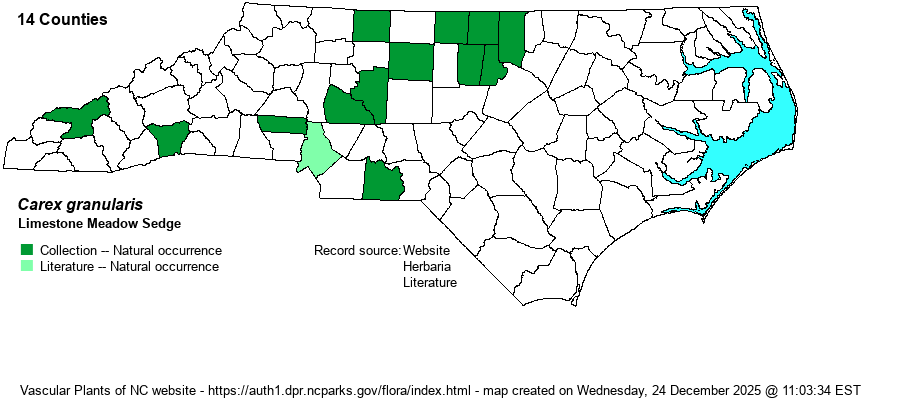| Author | Muhlenberg ex Willdenow | |
| Distribution | Found primarily in the northern Piedmont; local in the lower Mountains and the southern Piedmont.
ME and Que. to Sask., south to GA and northeastern TX. | |
| Abundance | Uncommon in the northeastern Piedmont, but rather rare southwest to Anson, Lincoln and Mecklenburg counties in the southern Piedmont. Very rare in the Mountains and western Piedmont; only 2 county records there. This is a Watch List species. Note that the NCNHP's State Rank of S1? is overly conservative, and the editors suggest S2S3. | |
| Habitat | Mesic to moist nutrient-rich forests and bottomlands, especially in openings over calcareous or mafic substrates. The Anson County population (discovered 2023) occurs on a moist open roadside in mafic soil with Scutellaria australis and Isolepis carinata. |
| Phenology | Flowering and fruiting May-June. | |
| Identification | Specimens formerly determined as C. granularis from Craven, Jones, and Pender counties are all C. gholsonii, a Coastal Plain endemic. Carex gholsonii may be distinguished from C. granularis by its green leaves (vs. glaucous in C. granularis) and its shorter leafy bract of the uppermost female spike (1.6-7 cm long vs. 4.1-15.8 cm long in C. granularis). | |
| Taxonomic Comments | Carex gholsonii has recently been split off from C. granularis.
The genus Carex is the largest in North America, and among the largest in the world. In temperate and boreal regions, Carex is often the dominant or co-dominant ground layer in many habitats. Seeds (achenes) are valuable food for birds and small mammals, while foliage is used by birds and mammals to make nests and as food by mammals. Species of Carex often look vastly different from one another -- spikes erect vs. drooping, tiny inflorescence vs. whopping, culms leafy vs. naked, perigynia beaked vs. beakless, stems densely bunched vs. single, etc. The genus has been divided into many sections (or groups), based on shared characters; some taxonomists have suggested that these be different genera, but that proves unworkable (so far). All Carex share the feature of a perigynium (an outer covering) which completely surrounds the achene (seed). This covering may fit tightly or loosely (like a small bladder), depending on which group or species. Details of perigynia shape, ornamentation, presence and size of beak, number of striations (or veins) are all important ID features. In recent years Rob Naczi and colleagues have stressed the importance of arrangement of perigynia -- whether spiral (3+ ranks) or distichous (2-ranked) -- and have named a number of new species as well as split off some older synonyms. Therefore, RAB's (1968) key, excellent for its time, can only be used in a general way today. Members of some sections of Carex are difficult to key out (notably Ovales, Laxiflorae, Griseae); this is in part due to variation among individuals of a species, or failings of the key. FNA has drawings of most species and some species may be found in two or more places within a key, to acount for variability. New species to NC, and new to science(!), continue to be found in NC. | |
| Other Common Name(s) | Meadow Sedge | |
| State Rank | S1? [S2S3] | |
| Global Rank | G5 | |
| State Status | W7 | |
| US Status | | |
| USACE-agcp | FACW link |
| USACE-emp | FACW link |

